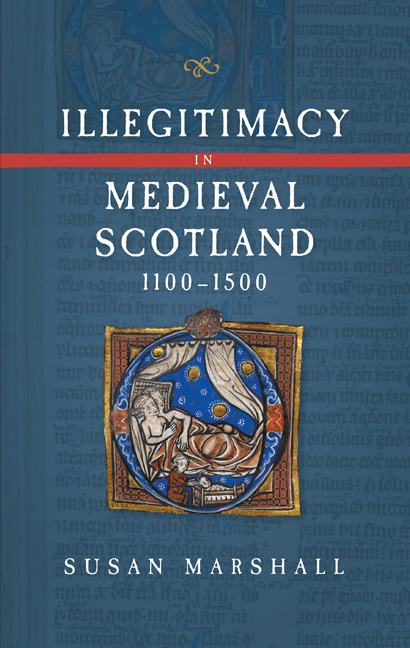Book contents
- Frontmatter
- Dedication
- Contents
- List of Tables
- Preface
- Acknowledgements
- Abbreviations
- Introduction
- 1 Church law and Scottish Families
- 2 Illegitimacy and Inheritance
- 3 Illegitimacy and Royal Succession I: Before the Great Cause
- 4 Illegitimacy and Royal Succession II: from the Great Cause to James I
- 5 Wives, Daughters, and Sisters
- 6 Church Careers and Sacrilegious Bastards
- 7 Illegitimacy in Political Life
- Conclusion
- Appendix I Scottish kings and their illegitimate offspring
- Appendix II Illegitimate sons of Scottish kings
- Timeline of key events
- Bibliography
- Index
- Frontmatter
- Dedication
- Contents
- List of Tables
- Preface
- Acknowledgements
- Abbreviations
- Introduction
- 1 Church law and Scottish Families
- 2 Illegitimacy and Inheritance
- 3 Illegitimacy and Royal Succession I: Before the Great Cause
- 4 Illegitimacy and Royal Succession II: from the Great Cause to James I
- 5 Wives, Daughters, and Sisters
- 6 Church Careers and Sacrilegious Bastards
- 7 Illegitimacy in Political Life
- Conclusion
- Appendix I Scottish kings and their illegitimate offspring
- Appendix II Illegitimate sons of Scottish kings
- Timeline of key events
- Bibliography
- Index
Summary
Illegitimacy in medieval Scotland has never been the subject of a book-length study. There is no Scottish equivalent of Given-Wilson and Curteis's 1984 book on illegitimate offspring of English medieval kings. Sara McDougall's more recent work, Royal Bastards, examines that topic in a number of Europe's developing royal dynasties, but does not include Scotland. Where scholarship on illegitimacy focuses on the Scottish situation, relatively little of it concerns the medieval era, the general exception being in the field of research into the papal archives. Even so, this tends to concentrate either on illegitimacy, with some reference to Scotland, or on Scotland, with some reference to illegitimacy. References to illegitimates in royal, noble and ecclesiastical life abound in Scottish historiography, but usually – where it is not scattered and piecemeal – as a subsidiary element of an investigation into something else.
As an undergraduate, stray references to medieval Scottish bastards and bastardy in my reading intrigued and frustrated in equal measure. It appeared that a person believing herself to be legitimate could find in an instant she was not, or an illegitimate person could just as rapidly have her status reversed. Bastards could not be heirs, but a few did inherit; illegitimate people were discriminated against in law, but some families apparently operated a ‘no bastards left behind’ policy. The Church was clear that the child should not be punished for the sins of the father, but equally certain that illicit sex left an imprint of sin on the character of the resulting offspring. Illegitimacy was a ‘defect’ rendering a person unfit for ecclesiastical office, but did not stop some from attaining the episcopate. Historians could not agree whether being illegitimate was a degraded and problematic status or a quotidian irrelevance, and rarely took the time to justify either position. The texts themselves were just as contradictory. ‘[T]his is customarily often distressing and shameful,’ wrote Bower of illegitimacy, but, ‘I see the cause for joy, but none for sorrow,’ said the future Pope Pius II of his illegitimate son. In writing this book, I have kept in mind my younger self; and if I have not have resolved all the contradictions, I have at least gathered together and set in context some of the diverse and fragmentary material relating to the Scottish experience of bastardy.
- Type
- Chapter
- Information
- Illegitimacy in Medieval Scotland1100-1500, pp. ix - xiPublisher: Boydell & BrewerPrint publication year: 2021

